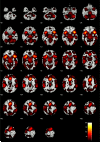Functional imaging of cognitive control during acute alcohol intoxication
- PMID: 20958334
- PMCID: PMC3005103
- DOI: 10.1111/j.1530-0277.2010.01332.x
Functional imaging of cognitive control during acute alcohol intoxication
Abstract
Background: The anterior cingulate and several other prefrontal and parietal brain regions are implicated in error processing and cognitive control. The effects of different doses of alcohol on activity within these brain regions during a functional magnetic resonance imaging (fMRI) task where errors are frequently committed have not been fully explored.
Methods: This study examined the impact of a placebo [breath alcohol concentration (BrAC) = 0.00%], moderate (BrAC = 0.05%), and high (BrAC = 0.10%) doses of alcohol on brain hemodynamic activity during a functional MRI (fMRI) Go/No-Go task in 38 healthy volunteers.
Results: Alcohol increased reaction time and false alarm errors in a dose-dependent manner. fMRI analyses showed alcohol decreased activity in anterior cingulate, lateral prefrontal cortex, insula, and parietal lobe regions during false alarm responses to No-Go stimuli.
Conclusions: These findings indicate that brain regions implicated in error processing are affected by alcohol and might provide a neural basis for alcohol's effects on behavioral performance.
Copyright © 2010 by the Research Society on Alcoholism.
Figures
References
-
- Aron AR. The neural basis of inhibition in cognitive control. Neuroscientist. 2007;13(3):214–28. - PubMed
-
- Battey LL, Heyman A, Patterson JL., Jr. Effects of ethyl alcohol on cerebral blood flow and metabolism. Journal of the American Medical Association. 1953;152(1):6–10. - PubMed
-
- Botvinick MM, Braver TS, Barch DM, Carter CS, Cohen JD. Conflict monitoring and cognitive control. Psychol Rev. 2001;108(3):624–52. - PubMed
-
- Botvinick MM, Cohen JD, Carter CS. Conflict monitoring and anterior cingulate cortex: an update. Trends in Cognitive Sciences. 2004;8(12):539–46. - PubMed
-
- Brett M. The MNI brain and the Talairach atlas. 2002.
Publication types
MeSH terms
Substances
Grants and funding
LinkOut - more resources
Full Text Sources



